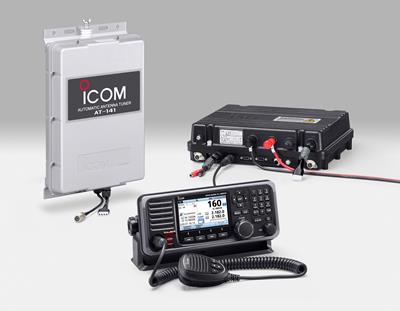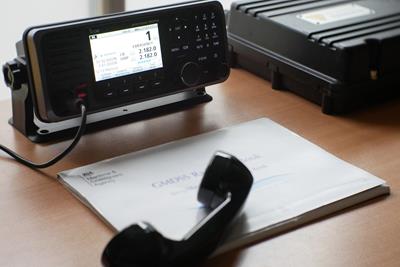Everything you Need to Know About the LRC (Long Range Certificate) Marine Qualification with Chieftain Training
Most mariners will be aware of the standard
SRC (Short Range Certificate) course which is mandatory should you want to use a Marine VHF radio at sea. Many people may not be aware of a more intensive and longer course. The LRC (Long Range Certificate) is required for sailors to operate an
MF/HF/VHF radio for voyages out of VHF range (30 – 40 miles) from a coastal radio station. This course is very specialised and one such provider, Chieftain Training provides this and other training from its Hamble and Helensburgh bases.
Chieftain Training is a "Not for profit" RYA and STCW (Standards of Training, Certification and Watchkeeping) training centre for recreational craft, super yachts and workboats. Training is provided in Survival, Engineering, First Aid,
Marine radio (GMDSS), Navigation and Powerboat handling. Most of the training is aimed at sail and motor yacht owners, skippers and crew. With no shareholders any profit made at Chieftain is ploughed straight back into its courses.
Its Director Doug Innes has been a Professional Sailor and Instructor for over 30 years. He delivers many of Chieftain's Long Range Certificate radio courses himself.
What is the Long Range Certificate (LRC)?
The Long-Range Certificate (LRC) includes everything in the SRC plus covers medium and long-range radio. Both courses are intended for operators of craft up to 24m. The SRC focuses on VHF (short range) radio and is suitable for those skippers operating in coastal waters, known as Sea area A1 i.e. within about 30 miles from a Maritime Rescue Coordination Centre (MRCC). The Long Range Certificate also includes Medium Frequency (MF) and High Frequency (HF). These are the radio options for Sea areas A2, A3 and A4, i.e. Offshore, Trans-Ocean and Polar regions.
As sailors operate further away from land, they need to become more self-sufficient in all areas of training, preparation and equipment. Consequently, not only does the LRC have additional content over the SRC, but it is more thorough on subjects such as EPIRBs, Navtex, voice procedures and distress working.
So why is it important for some students to gain the Long Range Certificate?
Doug said, 'Firstly, it is a legal requirement all over the world for anyone operating a marine radio/DSC set to hold the relevant Certificate of Competence (or be under the supervision of someone that is certificated). If there is an
SSB (MF and HF radio/DSC) on board, then there needs to be someone who holds the LRC (or GOC). On small craft this is usually the skipper. On many vessels there will be multiple crews qualified to operate the radio equipment.'
'Legislation aside, if you run into difficulties offshore and are fitted with an SSB set you must know how to use it. Remember that in a distress situation the skipper may be performing other critical functions or may be incapacitated themselves so having multiple crew that can operate this distress altering system is important. It is not just as simple as "pressing the red button.'
'If we assume a Maritime Rescue Co-ordination Centre (Coastguard) has an antenna height of 100m its VHF range to a motor vessel in distress (assuming an antenna height of 4m) could be about 30 miles. While the shoreside antenna height varies from station to station the 4m ships antenna is often the assumed height globally when National authorities set Sea Area A1. To a race yacht with a 16m antenna height this range might increase slightly to about 35 miles.'
'VHF is consequently appropriate for short range distress calling in coastal waters but anyone operating a yacht or motorboat outside Sea Area A1 should be considering fitting an MF/HF radio and if they choose to carry MF/HF they should also take the 4-day LRC course and exam. We also have three Icom SSB sets for MF and HF which are connected to a live antenna, so students can practice tuning into a real MF and/or HF signal. (Officers onboard vessels over 24m are required to hold the 8-day General Operator Certificate (GOC).'
Chieftain Training has a comprehensive range of VHF, MF and HF training radios. Doug said, 'We have eight Icom VHF sets in the training room, which are used for VHF/DSC and voice procedures. They are all connected to a live
Icom Class A VHF GM600 (which can emulate a coast guard station) and another set programmed as a duplex shoreside station. We also have three Icom SSB sets for MF and HF. They are connected to a live antenna so students can practice tuning into a real MF and/or HF signal.'
'We use a range of handheld VHFs, dummy EPIRBs, SARTS and six live Navtex sets. If students require the satellite module we have four PC satellite emulators.'
Why learn on real VHF Marine Training Radios?
Asked why it was important for students to learn on real equipment, Doug said, 'Some centres prefer to use computer simulators for MF and HF training. We feel that diesel engine maintenance is taught on real engines. We teach powerboating on real powerboats so why not teach MF and HF radio use on real radios? The only difference between our training set and the radio on your yacht is an Icom engineer has removed the transmitters from ours, so any Mayday or Distress alerts sent in the training suite are contained within the room.'
He added, 'If the worst ever happens and a student one day finds themselves in distress at sea they will revert to the training they received in the classroom. Using real kit, we can run realistic scenarios and ensure our students practice how real kit works. There is considerable anecdotal evidence that this has saved lives at sea.'
Having passed the end of course exam, students can apply for their MCA Certificate of Competence which is recognised by every developed (and most developing) nations in the world.
The certificate holder can then operate a marine radio on board any vessel (up-to 24m) at sea, anywhere on the planet. Our students are a mix of
• Oyster Word Rally, ARC rally (and other rally) Entrants
• Bluewater Cruisers
• Commercial Yachtmaster Offshore COC holders operating in Cat 1 waters (60-150 miles from a safe haven)
• Commercial Yachtmaster Ocean COC holders operating in Cat 0 waters (beyond 150 miles from safe haven)
• Workboat (up-to 24m) skippers/crew operating vessels beyond VHF range (Area A2, A3 and A4)
• Medics/Radio operators onboard some offshore rigs
Asked why Chieftain Training use
Icom marine radios in their training, Doug said, 'That is an easy one. I've been running training and charter vessels for nearly three decades. Throughout that time my experience is Icom radios stand up best to heavy use in harsh environments. Additionally, the after sales service (if required) is second to none. We therefore chose Icom for our RIBs and our motor yacht.'
'On the SRC course, we chose Icom DSCs because they are robust, have a large screen and have an intuitive menu system for our students.’
'When we decided to purchase new kit for the LRC course we looked at the options out there and it's not surprising that we found the most intuitive MF and HF sets and Class A VHF sets were also produced by Icom.'
Want to find out more?
If anyone wants to learn more about Chieftain Training and their range of marine courses, visit their website,
https://chieftain.training or call 02382 000 525.
Details on the Chieftain Training Long Range Certificate can be found at
https://chieftain.training/long-range-certificate-lrc/
.jpg)



